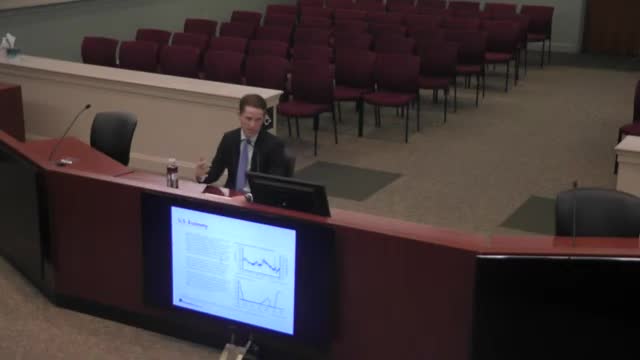Markets brace for potential Fed rate cuts amid Jackson Hole insights
August 23, 2024 | St. Mary's County, Maryland
This article was created by AI summarizing key points discussed. AI makes mistakes, so for full details and context, please refer to the video of the full meeting. Please report any errors so we can fix them. Report an error »

In a recent government meeting, discussions centered around the current state of the economy and market expectations, particularly in light of the upcoming Federal Reserve meetings. With only three meetings left this year, market analysts anticipate a potential rate cut of 50 basis points, rather than the standard 25, following a weaker unemployment report. This speculation coincides with the annual Jackson Hole symposium, where central bank leaders gather to discuss monetary policy. The keynote address by the Fed Chairman is expected to provide crucial insights into future monetary strategies.
The meeting also highlighted recent market performance, revealing that U.S. equities saw a modest increase of over 3% in the last quarter, while international equities experienced a slight decline. Emerging markets, however, reported gains of around 5%. Despite these overall positive returns, the bond market remained flat, indicating a slight rise in interest rates that pressured bond prices. Notably, Treasury Inflation-Protected Securities (TIPS) outperformed the investment-grade bond market, reflecting rising inflation expectations.
A deeper analysis of sector performance revealed that while the overall market return was positive, seven out of eleven sectors posted negative returns. This discrepancy was attributed to significant gains in a few large sectors, particularly communication services and information technology, which were driven by major companies like Meta and Apple. This concentration of gains presents challenges for active managers aiming to outperform the market.
The meeting concluded with a review of the fund's performance, noting a market value of $151.1 million at the end of the fiscal year. The fund achieved a return of 1.5% for the second quarter, aligning with its policy index benchmark. Positive contributions to performance were linked to strategic asset allocation, with an overweight in U.S. equities and a successful hedge fund investment. However, some active equity managers underperformed due to the market dynamics favoring larger companies.
Looking ahead, the meeting emphasized the importance of monitoring private market investments and the potential for future capital calls and distributions as the fund transitions towards a more liquid and lower-fee portfolio structure.
The meeting also highlighted recent market performance, revealing that U.S. equities saw a modest increase of over 3% in the last quarter, while international equities experienced a slight decline. Emerging markets, however, reported gains of around 5%. Despite these overall positive returns, the bond market remained flat, indicating a slight rise in interest rates that pressured bond prices. Notably, Treasury Inflation-Protected Securities (TIPS) outperformed the investment-grade bond market, reflecting rising inflation expectations.
A deeper analysis of sector performance revealed that while the overall market return was positive, seven out of eleven sectors posted negative returns. This discrepancy was attributed to significant gains in a few large sectors, particularly communication services and information technology, which were driven by major companies like Meta and Apple. This concentration of gains presents challenges for active managers aiming to outperform the market.
The meeting concluded with a review of the fund's performance, noting a market value of $151.1 million at the end of the fiscal year. The fund achieved a return of 1.5% for the second quarter, aligning with its policy index benchmark. Positive contributions to performance were linked to strategic asset allocation, with an overweight in U.S. equities and a successful hedge fund investment. However, some active equity managers underperformed due to the market dynamics favoring larger companies.
Looking ahead, the meeting emphasized the importance of monitoring private market investments and the potential for future capital calls and distributions as the fund transitions towards a more liquid and lower-fee portfolio structure.
View full meeting
This article is based on a recent meeting—watch the full video and explore the complete transcript for deeper insights into the discussion.
View full meeting
